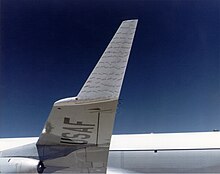Tuft (aeronautics)
Appearance
Look up tuft (aeronautics) in Wiktionary, the free dictionary.

In aeronautics, tufts are pieces of yarn or string, typically around 15 cm (6 in) long, attached to an aircraft surface in a grid pattern and imaged during flight. Their motion can be observed and recorded to locate air flow features such as boundary layer separation and reattachment. Tufting is, therefore, a technique for flow visualization. They are used during flight testing to study air flow direction, strength, and boundary layer properties.[citation needed]
The world's largest bed of tufts (18.6 m by 18.6 m, 61 feet by 61 feet) was created at NASA Ames Research Center to study air flow fields involving a helicopter's rotor disk.[1][2]
See also
[edit]References
[edit]- ^ Prouty, Ray (1 January 2009). Helicopter Aerodynamics Volume II. Lulu.com. ISBN 9780557090440. Retrieved 19 October 2016 – via Google Books.
- ^ Wadcock, Alan J. (October 2008). "Rotorcraft Downwash Flow Field Study to Understand the Aerodynamics of Helicopter Brownout" (PDF). Defense Technical Information Center (DTIC). Retrieved 1 November 2022.
